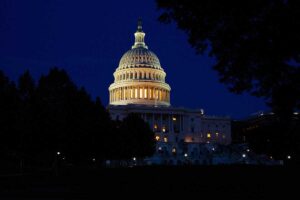Loan Options Provide Financial Relief For Small Businesses

(Post updated April 8, 2020, to reflect the most current information about the Paycheck Protection Program)
The Coronavirus Aid, Relief, and Economic Security Act (CARES Act) is one of the largest stimulus bills in American history and provides much needed financial relief to many millions of Americans. Of particular note for businesses are several loan options administered by the US Small Business Administration (SBA), including the Economic Injury Disaster Loan (EIDL, discussed in more detail here) and the $349-billion Paycheck Protection Program (PPP).
The PPP allows eligible businesses to weather the COVID-19 pandemic by providing federally guaranteed, forgivable loan assistance to maintain payroll and certain other costs. The main features of the PPP include tax-free loan forgiveness of some or all of the principal amount, elimination of SBA fees, six-month loan payment deferral, a flat 1% interest rate, and the lack of a personal guarantee or pledge of collateral by the business owner.
How to Apply For a PPP Loan
Applications for PPP loans can be made through existing SBA lenders and other lenders once they have enrolled and been approved. Check here for a list of current SBA lenders. A sample PPP loan application is available here.
Small businesses and sole proprietorships can start applying for PPP loans on April 3, 2020. Independent contractors and other self-employed individuals can start applying for PPP loans on April 10, 2020. PPP loans are available for Payroll Costs and certain other expenses incurred between February 15 and June 30, 2020.
As there are limited funds available, borrowers should submit their applications for PPP loans as soon as possible.
Which borrowers are eligible?
Any business with 500 or fewer employees. This includes independently owned franchises, religious organizations, 501(c)(3) nonprofit organizations, 501(c)(19) veterans organizations, 31(b)(2)(c) Tribal organizations, sole proprietors, and independent contractors.
How much will my business receive?
PPP loans are capped at the lesser of $10 million or 250% of the average monthly payroll history.
For eligible businesses in existence between February 15, 2019 (or March 1, 2019, for businesses with seasonal workers), and June 30, 2019, the average monthly payroll history will be calculated based on the business’ average monthly Payroll Costs for the 12 months prior to the loan origination date. For eligible businesses not in existence by June 30, 2019, the monthly payroll history will be calculated based on the business’ average monthly Payroll Costs for the period January 1, 2020, to February 29, 2020.
How can my business use the loan proceeds?
How PPP loan proceeds are used will impact how much of the loan will be forgiven. Importantly, the CARES Act does not require a borrower to maintain a separate bank account for the PPP proceeds.
To maximize loan forgiveness, PPP loan proceeds should be used for Payroll Costs; mortgage interest (but not principal) on any mortgage obligation incurred before February 15, 2020; rent for leases in force before February 15, 2020; and utility services (e.g., electric, telephone, internet) beginning before February 15, 2020. Borrowers will need to institute good records retention policies to ensure maximal loan forgiveness as borrowers will need to submit documentation of such costs when seeking PPP loan forgiveness.
The CARES Act and recent guidance from the SBA issued on April 7, 2020, provide that the term “Payroll Costs” includes employee and owner cash compensation, up to a limit of $100,000 in the form of salaries, wages, commissions, or similar compensation, and cash tips or the equivalent. Benefits in the form of non-cash compensation are also included as Payroll Costs without regard to the $100,000 cash-compensation limit and include the following items: (i) payment for vacation pay and parental, family, medical or sick leave; (ii) allowance for dismissal or separation; (iii) payments required for the provision of group health care benefits, including insurance premiums; (iv) payments of any retirement benefit (including defined-benefit and defined-contribution retirement plans); and (v) payments of state or local tax assessed on employee compensation.
The CARES Act specifically excludes the following items from the term “Payroll Costs”: (i) the portion of employee and owner salaries in excess of $100,000 (exclusive of non-cash compensation benefits); (ii) employer-paid FICA and federal payroll taxes; (iii) compensation of an employee whose principal place of residence is outside the US; and (iv) qualified sick and family leave for which a credit is available under the Families First Coronavirus Response Act.
Employee bonuses are not explicitly addressed by the CARES Act or any SBA regulations or guidance issued to date. Based on our analysis of what has been addressed by the SBA to date, we predict that the SBA would deem employee bonuses as cash compensation subject to the $100,000 per employee limit. Future SBA regulations and guidance will likely address this issue more specifically.
Are PPP loans forgivable?
PPP loans may be forgiven up to the principal amount of the loan. Any amounts forgiven will not be taxable to the borrower for federal tax purposes. Whether Pennsylvania or other states, will follow suit remains to be seen.
Total PPP loan forgiveness is principally dependent on how the loan proceeds are used. Subject to additional restrictions, amounts spent on Payroll Costs for the 8-week period following the loan origination date will be 100% forgiven; amounts spent on mortgage interest, rent, and utility services during this 8-week period will also be forgiven. Payroll Costs must account for at least 75% of the total amount forgiven, and non-Payroll Costs cannot exceed 25% of the total amount forgiven.
Total loan forgiveness will be reduced for any decreases that occur in full-time employee headcount or decreased employee compensation. For workforce reduction, loan forgiveness reduction will be proportional to the average monthly number of full-time employees employed during the 8-week period following loan origination and the average monthly number of full-time employees employed during either the February 15, 2019, to June 30, 2019 time period, or January 1, 2020, to February 29, 2020 time period; with the borrower choosing the applicable pre-loan time period. For decreased employee compensation, loan forgiveness will be reduced by the amount of the decreased compensation exceeding 25% for any employee who made less than $100,000 during the most recent pre-PPP loan quarter in which that employee was employed.
Loan forgiveness will not be reduced, however, where the borrower rehires full-time employees so that its employment level meets or exceeds the full-time average monthly employee figure on June 30, 2020. In addition, there will be no reduction in loan forgiveness if the borrower eliminates any 25% decrease in an employee’s compensation by June 30, 2020.
Borrowers will need to apply to their lenders for PPP loan forgiveness. In their application for loan forgiveness, borrowers will need to submit documentation sufficient to demonstrate payment of Payroll Costs, mortgage interest, rent, and utility services. Good record retention policies are therefore a must for borrowers. As borrowers will need to prove such payments, borrowers should wait until the end of the 8-week period after loan origination to apply for forgiveness. Once an application for loan forgiveness has been received, the lender must render its decision on the application within 60 days.
Any loan amounts not forgiven will be placed on a 2-year payment plan starting from the loan forgiveness application date. In addition, there is no prepayment penalty for paying off the loan prior to the maturity date.
To discuss these sources of capital for your business, please contact an attorney at The Lynch Law Group.
Pittsburgh Corporate Attorneys
Contact Dan Lynch, managing partner of The Lynch Law Group, at (724) 776-8000 or dlynch@lynchlaw-group.com for more information.




